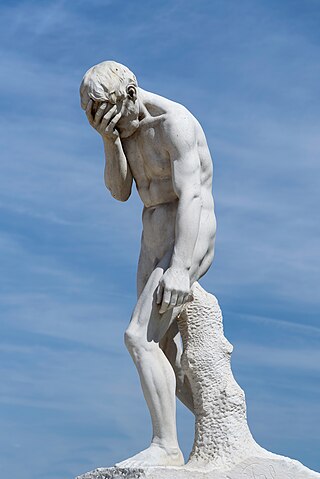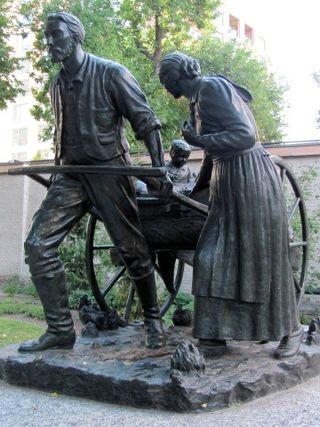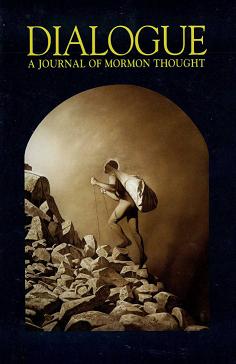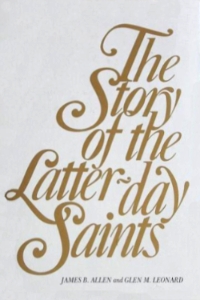Related Research Articles
Early Mormonism had a range of doctrines related to race with regards to Black people of African descent. References to Black people, their social condition during the 19th and 20th centuries, and their spiritual place in Western Christianity as well as in Mormon scripture were complicated.

In the Latter Day Saint movement the second anointing is the pinnacle ordinance of the temple and an extension of the endowment ceremony. Founder Joseph Smith taught that the function of the ordinance was to ensure salvation, guarantee exaltation, and confer godhood. In the ordinance, a participant is anointed as a "priest and king" or a "priestess and queen", and is sealed to the highest degree of salvation available in Mormon theology.

Elijah Abel, or Able or Ables was one of the earliest African-American members of the Church of Jesus Christ of Latter-day Saints, and was the church's first African-American elder and Seventy. Abel was predominantly of Scottish and English descent and appears to have been the first, and one of the few, black members in the early history of the church to have received Priesthood ordination, later becoming the faith's first black missionary. Abel did not have his ordination revoked when the LDS Church officially announced its now-obsolete restrictions on Priesthood ordination, but was denied a chance to receive his temple endowment by third church president John Taylor. As a skilled carpenter, Abel often committed his services to the building of LDS temples and chapels. He died in 1884 after serving a mission to Cincinnati, Ohio, his last of three total missions for the church.
During the history of the Latter Day Saint movement, the relationship between Black people and Mormonism has included enslavement, exclusion and inclusion, and official and unofficial discrimination. Black people have been involved with the Latter Day Saint movement since its inception in the 1830s. Their experiences have varied widely, depending on the denomination within Mormonism and the time of their involvement. From the mid-1800s to 1978, Mormonism's largest denomination – the Church of Jesus Christ of Latter-day Saints – barred Black women and men from participating in the ordinances of its temples necessary for the highest level of salvation, prevented most men of Black African descent from being ordained into the church's lay, all-male priesthood, supported racial segregation in its communities and schools, taught that righteous Black people would be made white after death, and opposed interracial marriage. The temple and priesthood racial restrictions were lifted by church leaders in 1978. In 2013, the church disavowed its previous teachings on race for the first time.

The curse of Cain and the mark of Cain are phrases that originated in the story of Cain and Abel in the Book of Genesis. In the stories, if someone harmed Cain, the damage would come back sevenfold. Some interpretations view this as a physical mark, whereas other interpretations see the "mark" as a sign, and not as a physical mark on Cain himself. The King James Version of the Bible reads "set a mark upon Cain".

The Mormon religion is predicated on what are said to be historical events such as the First Vision of Joseph Smith and the historicity of the Book of Mormon, which describes a detailed pre-Columbian history of the Americas. Joseph Fielding Smith, the tenth president of the Church of Jesus Christ of Latter-day Saints, declared that "Mormonism, as it is called, must stand or fall on the story of Joseph Smith. He was either a prophet of God, divinely called, properly appointed and commissioned, or he was one of the biggest frauds this world has ever seen. There is no middle ground." As Jan Shipps has written, "Mormonism, unlike other modern religions, is a faith cast in the form of history," and until after World War II, Mormons did not critically examine the historical underpinnings of their faith; any "profane" investigation of the church's history was perceived "as trespassing on forbidden ground."

Dialogue: A Journal of Mormon Thought is an independent quarterly journal that addresses a wide range of issues on Mormonism and the Latter Day Saint Movement.
In the Church of Jesus Christ of Latter-day Saints, the priesthood is the power and authority to act in the name of God for the salvation of humankind. Male members of the church who meet standards of worthy behavior and church participation are generally ordained to specific offices within the priesthood.

The 1978 Revelation on Priesthood was an announcement by leaders of the Church of Jesus Christ of Latter-day Saints that reversed a long-standing policy excluding men of Black African descent from ordination to the denomination's priesthood and both Black men and women from priesthood ordinances in the temple. Leaders stated it was a revelation from God.

The Story of the Latter-day Saints is a single-volume history of the Church of Jesus Christ of Latter-day Saints by James B. Allen and Glen M. Leonard, first published in 1976.
James Brown Allen is an American historian of Mormonism and was an official Assistant Church Historian of the Church of Jesus Christ of Latter-day Saints from 1972 to 1979. While working as Assistant Church Historian, he co-authored The Story of the Latter-day Saints with Glen Leonard. After Ezra Taft Benson dismissed the book as secular new history, other events led to the dissolution of the LDS Church History department in 1982. Allen resigned as Assistant Church Historian in 1979, returning to work at Brigham Young University (BYU) full-time.
Mormon studies is the interdisciplinary academic study of the beliefs, practices, history and culture of individuals and denominations belonging to the Latter Day Saint movement, a religious movement associated with the Book of Mormon, though not all churches and members of the Latter Day Saint movement identify with the terms Mormon or Mormonism. Denominations of the Latter Day Saint movement include the Church of Jesus Christ of Latter-day Saints, by far the largest, as well as the Community of Christ (CoC) and other smaller groups, include some categorized under the umbrella term Mormon fundamentalism.
From 1852 to 1978, temple and priesthood policies in the Church of Jesus Christ of Latter-day Saints prohibited both Black women and Black men from temple ordinances and ordination in the all-male priesthood. In 1978, the church's highest governing body, the First Presidency, declared in the statement "Official Declaration 2" that the restriction had been lifted. Between 1830 and 1852, a few Black men had been ordained to the Mormon priesthood in the Latter Day Saint movement under Joseph Smith.

Since Mormonism's foundation, Black people have been members, however the church placed restrictions on proselytization efforts among Black people. Before 1978, Black membership was small. It has since grown, and in 1997, there were approximately 500,000 Black members of the church, mostly in Africa, Brazil and the Caribbean. Black membership has continued to grow substantially, especially in West Africa, where two temples have been built. By 2018, an estimated 6% of members were Black worldwide. In the United States, approximately 1% of members are Black.
In the Church of Jesus Christ of Latter-day Saints, marriage between a man and a woman is considered to be "ordained of God". Marriage is thought to consist of a covenant between the man, the woman, and God. The church teaches that in addition to civil marriage, which ends at death, a man and woman can enter into a celestial marriage, performed in a temple by priesthood authority, whereby the marriage and parent–child relationships resulting from the marriage will last forever in the afterlife.

The following outline is provided as an overview of and a topical guide to the Church of Jesus Christ of Latter-day Saints.
In the past, leaders of the Church of Jesus Christ of Latter-day Saints have consistently opposed marriages between members of different ethnicities, though interracial marriage is no longer considered a sin. In 1977, apostle Boyd K. Packer publicly stated that "[w]e've always counseled in the Church for our Mexican members to marry Mexicans, our Japanese members to marry Japanese, our Caucasians to marry Caucasians, our Polynesian members to marry Polynesians. ... The counsel has been wise." Nearly every decade for over a century—beginning with the church's formation in the 1830s until the 1970s—has seen some denunciations of interracial marriages (miscegenation), with most statements focusing on Black–White marriages. Church president Brigham Young taught on multiple occasions that Black–White marriage merited death for the couple and their children.
This is a bibliography of works on the Latter Day Saint movement.
Joseph Smith's views on Black people varied during his lifetime. As founder of the Latter Day Saint movement, he included Black people in many ordinances and priesthood ordinations, but held multi-faceted views on racial segregation, the curses of Cain and Ham, and shifted his views on slavery several times, eventually coming to take an anti-slavery stance later in his life.
References
- ↑ Bush, Lester E. Jr. (Spring 1999), "Writing "Mormonism's Negro Doctrine: An Historical Overview" (1973): Context and Reflections, 1998", Journal of Mormon History , 25 (1): 229–271, JSTOR 23287744 , retrieved 2023-09-04
- ↑ "Lester E. Bush photographic collection, 1880-1886". 295 South 1500 East, Salt Lake City, UT 84112-0860: University of Utah Libraries, Special Collections, J. Willard Marriott Library. Retrieved 2023-09-04.
{{cite web}}: CS1 maint: location (link) - ↑ Bush, Lester E. Jr. (Spring 1973), "Mormonism's Negro Doctrine: An Historical Overview" (PDF), Dialogue: A Journal of Mormon Thought , 8 (1): 11–68, doi:10.2307/45227533, JSTOR 45227533 , retrieved 2023-09-04
- ↑ Kimball, Edward L. (2008), "Spencer W. Kimball and the Revelation on Priesthood" (PDF), BYU Studies Quarterly , 47 (2): 4–78, retrieved 2023-09-06
- ↑ Arrington, Leonard J. (1998), Adventures of a Church Historian, University of Illinois, p. 175
- ↑ Nielsen, Chad L. (2013), "Leveraging Doubt: The Impact of Lester E. Bush, Jr.'s "Mormonism's Negro Doctrine" A Historical Overview"", Arrington Student Writing Award Winners: 2–3, retrieved 2023-09-09
- ↑ G., David; Stephen J. Fleming (January 25, 2010). "Revisiting: "Mormonism's Negro Doctrine: An Historical Overview"". Juvenile Instructor. Retrieved 2023-09-06.